by GardenLover | Jan 2, 2016 | Books Notes
Winter Contemplation and Planning
By Debra Knapke
Winter is a good time to curl up with a cup of tea and a good book. For your reading pleasure, I offer a diverse collection of books to add to your personal collection or to borrow from your favorite library.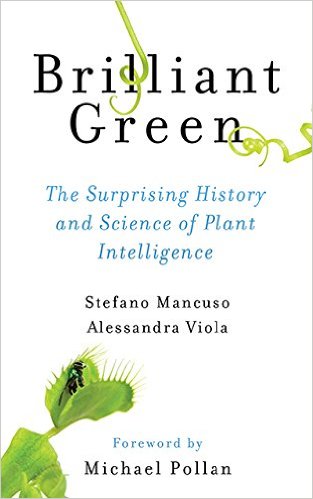
In November I attended a lecture on plant “neurobiology” given by Dr. Stefano Mancuso*. The message of his talk: plants are intelligent and we need to understand that intelligence from a plant’s frame-of-reference. After taking four pages of notes, I decided that I needed to purchase his book Brilliant Green: The Surprising History and Science of Plant Intelligence. Dr. Mancuso’s book is a mix of science and philosophy that is easy to grasp. When explaining how the roots act as the brain of a plant, Mancuso describes how roots make complex decisions for the “good of the plant”: discerning where nutrients and water are; avoiding or neutralizing toxic substances. In 173 pages, this book may change what you thought you knew about plants.
In my November 7, 2012, post I reviewed Daniel Chamovitz’s book What a Plant Knows. If you read it and enjoyed it, the above will continue that reading thread.
For a visual feast, take a look at Ken Druse’s The New Shade Garden: Creating a Lush Oasis in the Age of Climate Change. 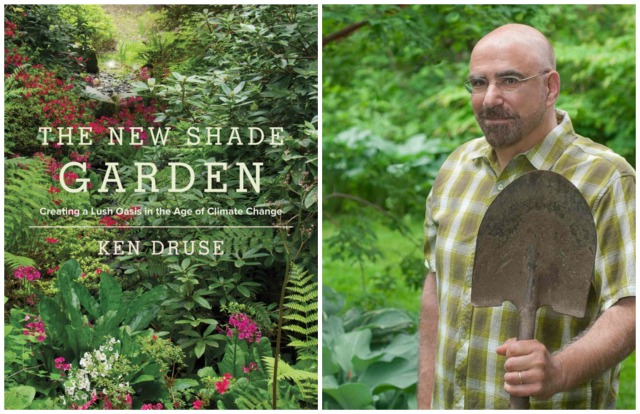 This is an update of his 1992 book The Natural Shade Garden which has held an honored place on my bookshelf and in my design classes. I find that updates are nice, but they often don’t offer much more than the original. This is not the case with The New Shade Garden. Druse discusses the issues of lawn, chemical use, the slippery classifications of native-local-nonnative plants, and sustainability. His guidance for matching plant combinations to garden conditions is excellent. He states, “The garden of the future will be a shade garden.” Why? Trees and their associated ecosystems are an essential part of our mature forests. Plus, they offer ecological services such as carbon sequestration, modifying temperature around buildings, stormwater control and more.
This is an update of his 1992 book The Natural Shade Garden which has held an honored place on my bookshelf and in my design classes. I find that updates are nice, but they often don’t offer much more than the original. This is not the case with The New Shade Garden. Druse discusses the issues of lawn, chemical use, the slippery classifications of native-local-nonnative plants, and sustainability. His guidance for matching plant combinations to garden conditions is excellent. He states, “The garden of the future will be a shade garden.” Why? Trees and their associated ecosystems are an essential part of our mature forests. Plus, they offer ecological services such as carbon sequestration, modifying temperature around buildings, stormwater control and more.
I have a tough decision to make: to buy or not to buy – my “review copy” is from the library. And if I buy, what do I do with my old friend The Natural Shade Garden?
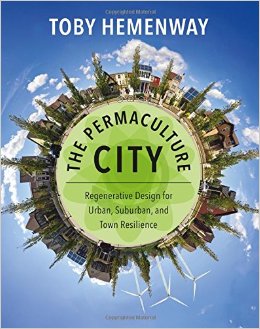 Another library find was Toby Hemenway’s The Permaculture City: Regenerative Design for Urban, Suburban and Town Resilience. You may be familiar with his excellent guide to creating a sustainable home garden: Gaia’s Garden: a Guide to Home-Scale Permaculture. In The Permaculture City, Hemenway expands the scope of his first book; starting at the home garden – focusing especially on urban sites, then branching out into the community. His topics range from understanding, using and protecting water sources of the community to creating local money systems that sustain a community. The latter topic offers a different way to think about money and banks. As in Gaia’s Garden, Hemenway offers examples and practical applications of permaculture techniques and concepts.
Another library find was Toby Hemenway’s The Permaculture City: Regenerative Design for Urban, Suburban and Town Resilience. You may be familiar with his excellent guide to creating a sustainable home garden: Gaia’s Garden: a Guide to Home-Scale Permaculture. In The Permaculture City, Hemenway expands the scope of his first book; starting at the home garden – focusing especially on urban sites, then branching out into the community. His topics range from understanding, using and protecting water sources of the community to creating local money systems that sustain a community. The latter topic offers a different way to think about money and banks. As in Gaia’s Garden, Hemenway offers examples and practical applications of permaculture techniques and concepts.
There are many who believe that it will be our urban and suburban food farms that feed us in the future, and that robust local governance is important for a healthy world. If you wish to explore these ideas further, this book will be an excellent guide.
Full Disclosure: I was sent The Allergy Fighting Garden: Stop Asthma and Allergies with Smart Landscaping by the author, Thomas Leo Ogren, 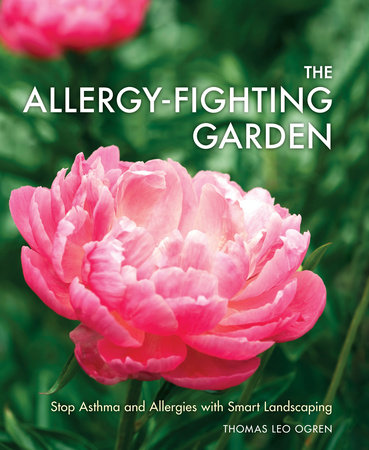 to peruse and review if I felt it was worthy. I enjoyed the author’s previous book Safe Sex in the Garden and Other Propositions for an Allergy-free World (2004) and was curious about his next step. In The Allergy Fighting Garden, Ogren combines and expands his two earlier books: Allergy Free Gardening (2000) and Safe Sex in the Garden. He offers a concise presentation of his rating scale, OPALS (Ogren Plant Allergy Scale), for allergen producing plants and a comprehensive list of garden plants that are rated for their allergen-producing potential. His rationale for his scale is based on solid plant science and is easy to understand. The scale is 1-10 with 1 being “least allergenic” and 10 being “most allergenic”. For example: boxwood rates a 7 because the male flowers need to make enough pollen to reach the female flowers, via the wind, that are on separate plants (boxwood is dioecious-having different sexed flowers on separate plants). Ogren also notes that boxwood can cause a dermatitis reaction for sensitive individuals.
to peruse and review if I felt it was worthy. I enjoyed the author’s previous book Safe Sex in the Garden and Other Propositions for an Allergy-free World (2004) and was curious about his next step. In The Allergy Fighting Garden, Ogren combines and expands his two earlier books: Allergy Free Gardening (2000) and Safe Sex in the Garden. He offers a concise presentation of his rating scale, OPALS (Ogren Plant Allergy Scale), for allergen producing plants and a comprehensive list of garden plants that are rated for their allergen-producing potential. His rationale for his scale is based on solid plant science and is easy to understand. The scale is 1-10 with 1 being “least allergenic” and 10 being “most allergenic”. For example: boxwood rates a 7 because the male flowers need to make enough pollen to reach the female flowers, via the wind, that are on separate plants (boxwood is dioecious-having different sexed flowers on separate plants). Ogren also notes that boxwood can cause a dermatitis reaction for sensitive individuals.
While we can’t get rid of all pollen – and we don’t want to – this book offers an allergy-sufferer a way to design a garden that decreases potential allergic reactions.
So begins my season of reading; enjoy yours!
* Dr. Mancuso the director and founder of the International Laboratory of Plant Neurobiology in Florence, Italy and is also the founder of International Society for Plant Signaling and Behavior.
NOTE: On Jan. 10, catch our blog’s favorite author Debra Knapke at the P.L.A.N.T. Seminar presented by the Perennial Plant Association and The Ohio State University Master Gardener Volunteers at the Greater Columbus Convention Center. With her talk “Garden Design Informed by Ecology & Place,” she will join an impressive line-up of speakers including Stephanie Cohen, Kelly Norris, Jason Reeves, Gene Bush and John Friel.
by GardenLover | Dec 15, 2015 | Gardens to Drive
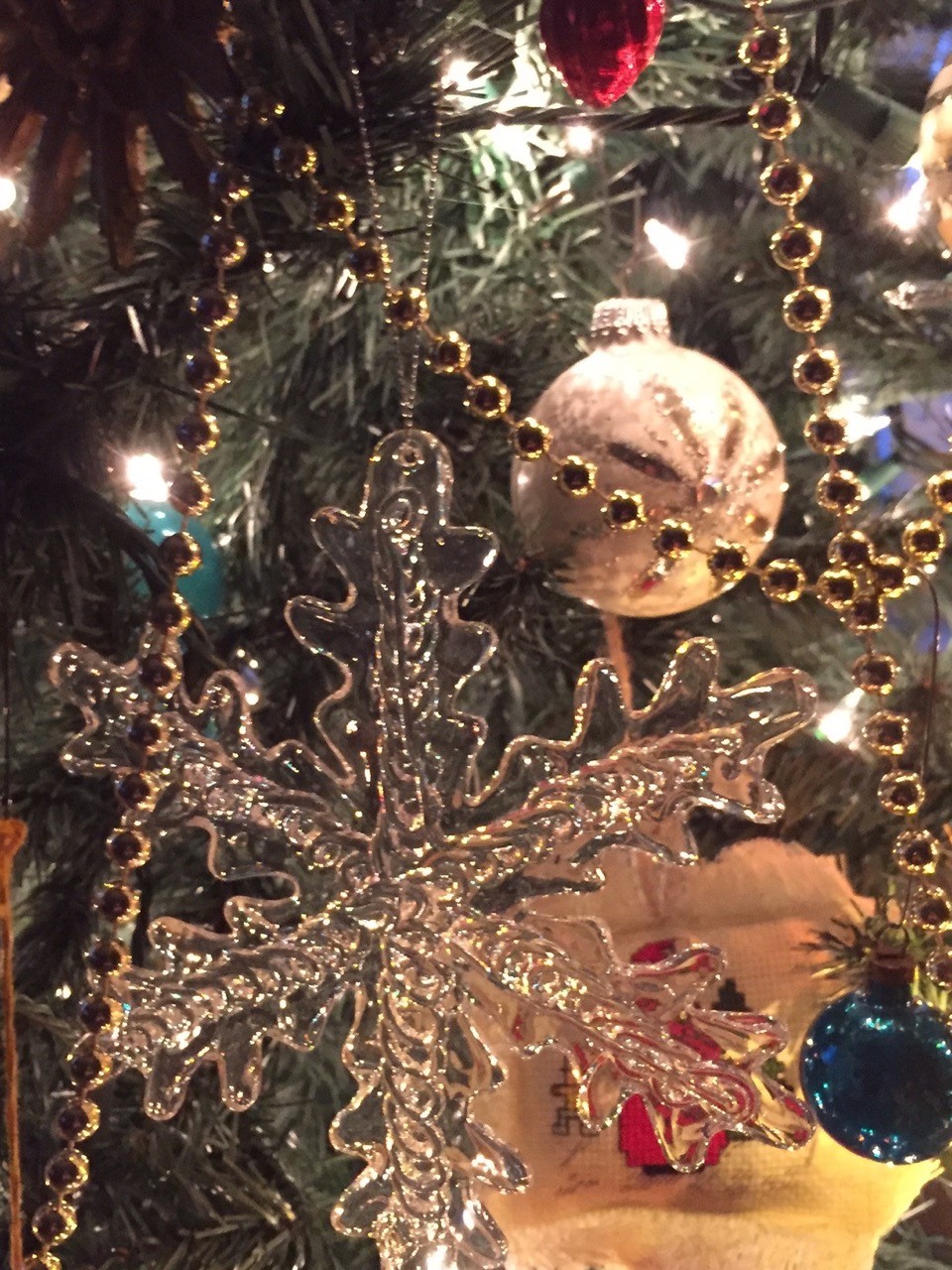
Ladened with family keepsakes, gifts and souvenirs, any tree, real or fake, is star of the holiday show.
Bah humbug! Tis the season’s real meaning that counts
By Michael Leach
A pointless debate arises every year Christmas season — real or fake. Tis one of many irrelevant “traditions” that detract from the true meaning of this special season.
“A Charlie Brown Christmas” helped torpedo sales of silvery aluminum trees when it first aired on television a half century ago and seemed to give wooden trees an unbeatable lead. Even spindly (may we say scraggly?) real trees became adorable. But not at our house.
Ironically, my sister and I, not our parents, championed a faux fir. This was anathema to our parents. During our early childhood years Father bought a live tree. After the holidays, most were planted in a windbreak along the west side of the back yard where a few continue to thrive. Our first live Christmas tree now towers far higher than the family home place.
But wrestling a tree growing from a fat ball of lead-like soil eventually offset the charm of a living memorial to our favorite holiday. Enter cut trees.
After several years, this also came to a halt. Our last tree shopping day is described perfectly in a rather somber carol, “Frosty wind made moan, Earth stood hard as iron, Water like a stone …In the bleak midwinter, long ago.” Three of our perfectionist family of four went from tree to tree at several lots.
Bleak got bleaker. Even when Sister, Father and I finally agreed on a specimen, Mother would nix it. Sitting in the warmth of the car, idling to keep the heater blasting sufficiently to melt iron, she would offer a faint sneer and several shakes of her head.
Finally fatigue prevailed. We toted home a less than perfect tree. It’s flawed state was quickly altered by Father and I. We sawed off the crooked bottom of the trunk. We snipped back a few bushy branches, and drilled holes to insert them into the trunk to give the tree a fuller, more symmetrical effect. (Back then, virtually all trees had a good side, positioned to face into the living room, and a bad side rammed against a wall or window.)
Real tree enthusiasts swoon over the scent of fresh pine or other conifer. Ours smelled of fire retardant. Father took no chances.
Mother had the dreary task of filling the water pan of the metal tree stand every day to ensure Tannenbaum remained as green and life-like as possible. She emerged with long, dangly tinsel icicles and prickly needles decorating her bouffant hairdo. What she uttered during cleanup was anything but tidings of joy.
As Sister and I refused to risk frost-bitten limbs another year, we bought a rather lifelike Pinus plasticus.
My current fake tree is about 25 years old and sheds almost as badly as the brittle spruces that will soon line the curbs. Yet it has a certain nostalgic value no cut-and-toss wooden tree can boast. Plus, it decorates more easily than the real deal. Need that ornament to hang an inch or so to the right? No problem. Bend the branch.
But I digress.
Your choice in trees is strictly personal. We won’t settle the debate by arguing. What I hope we can all agree to is that Christmas, which represents the coming of light, hope, new life, and peace is more needed than usual this year.
by GardenLover | Nov 27, 2015 | Special Topic
What our garden inhabitants might be saying about us
By Debra Knapke
It’s the day after Thanksgiving and even the backyard critters are weighing in their thanks.
From the birds: We have enjoyed the seed cones and suet you have placed outside. The new spicy seeds and suet are epicurean delights.
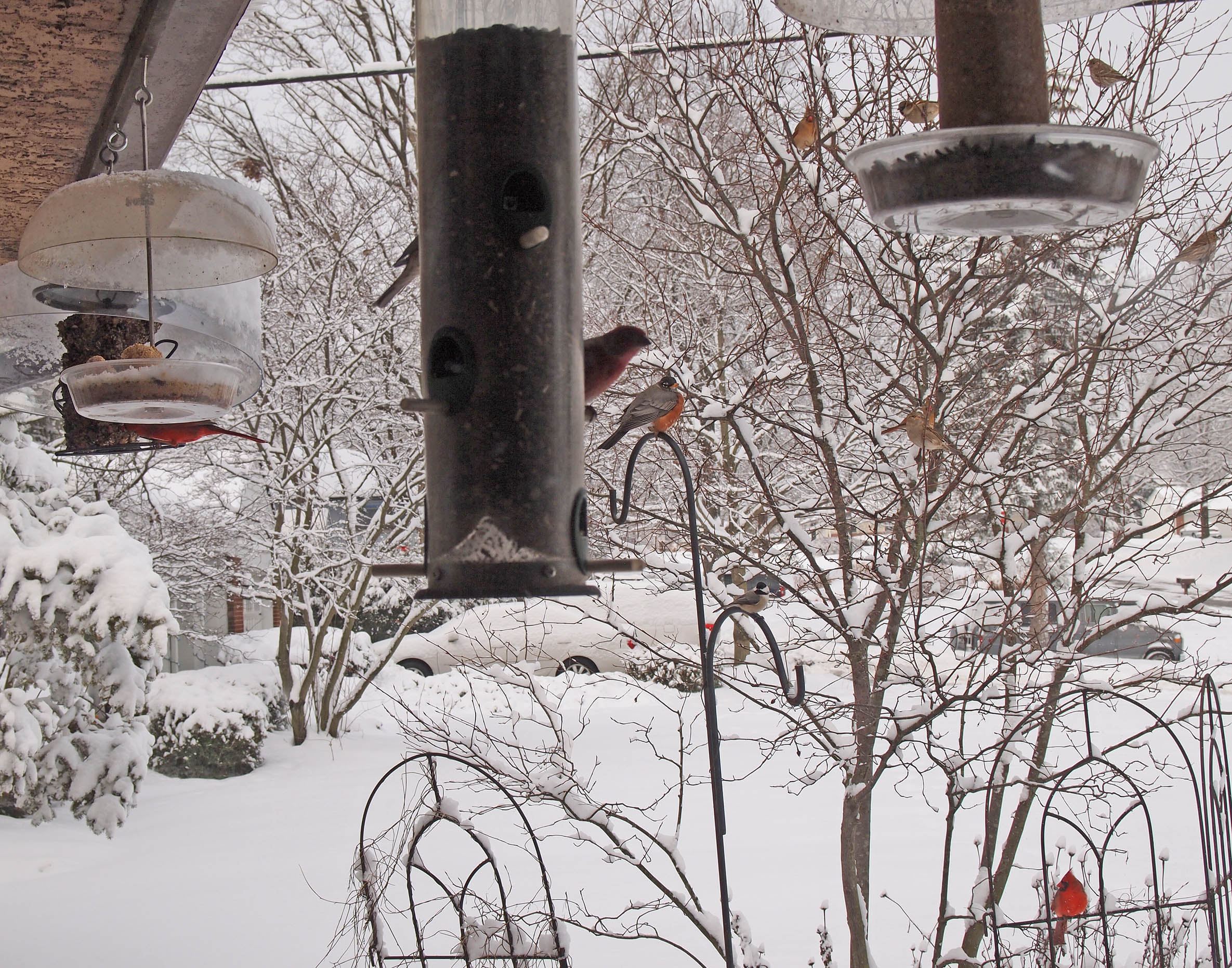
From the squirrels: Thank you for all the food you have put out for us. Our problem-solving skills have greatly improved as we have played the games you have so nicely provided for us. Please note: we do not like the spicy seed cones and suet that you have provided this year.
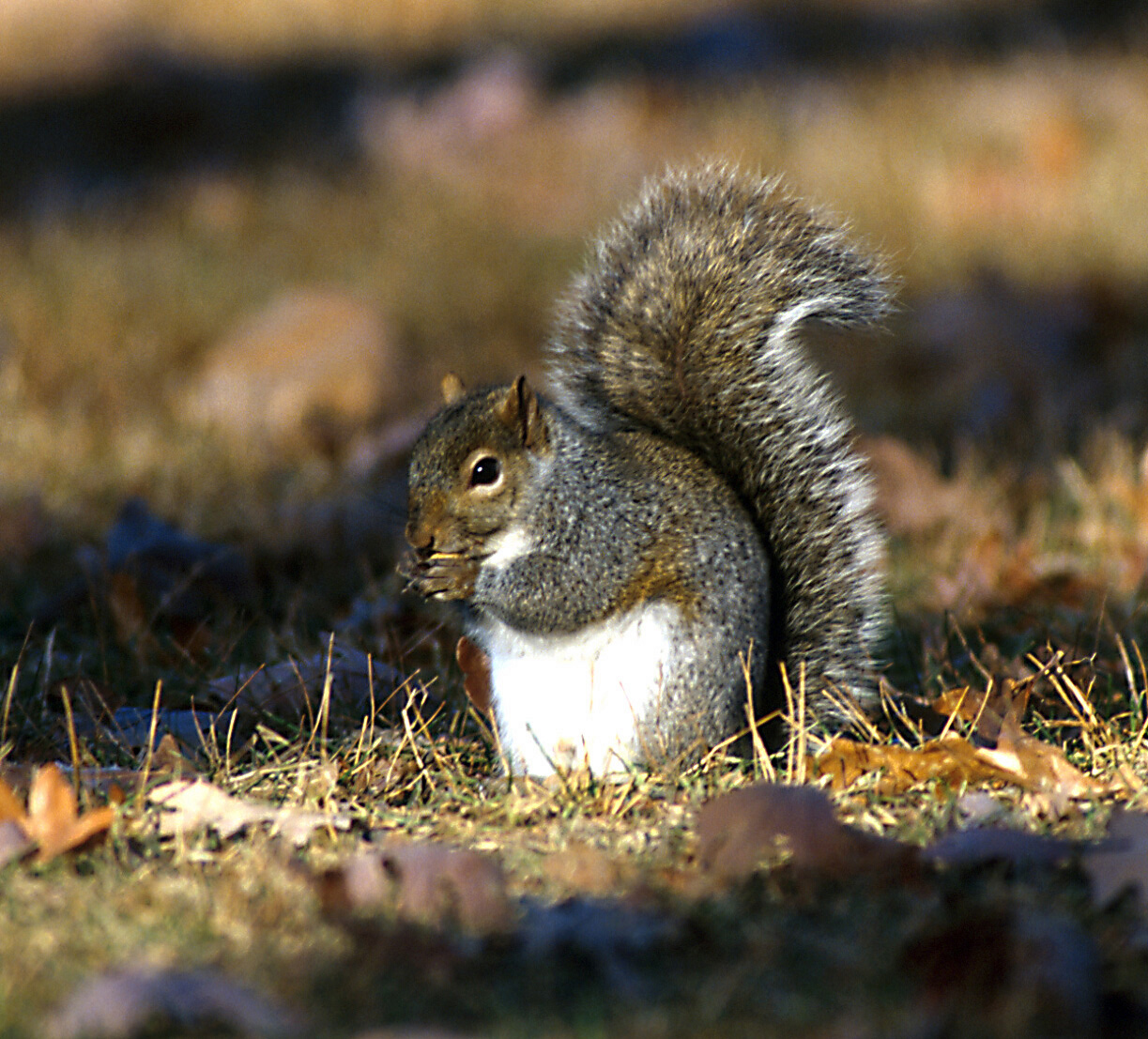
Photo from Ohio Dept. of Natural Resources
From the skunks and opossums: Thank you for the kitchen scraps that you kindly left out last year. We noticed that you are now placing them inside the large fenced-in area. Please consider leaving the scraps in a more accessible location; we deserve a pleasant Thanksgiving, too.

Photo from Ohio Dept. of Natural Resources
From the frogs and toads: We have enjoyed the moist places you have provided for us in your bog and rain lily pots. The area under the fig tree is nice, too.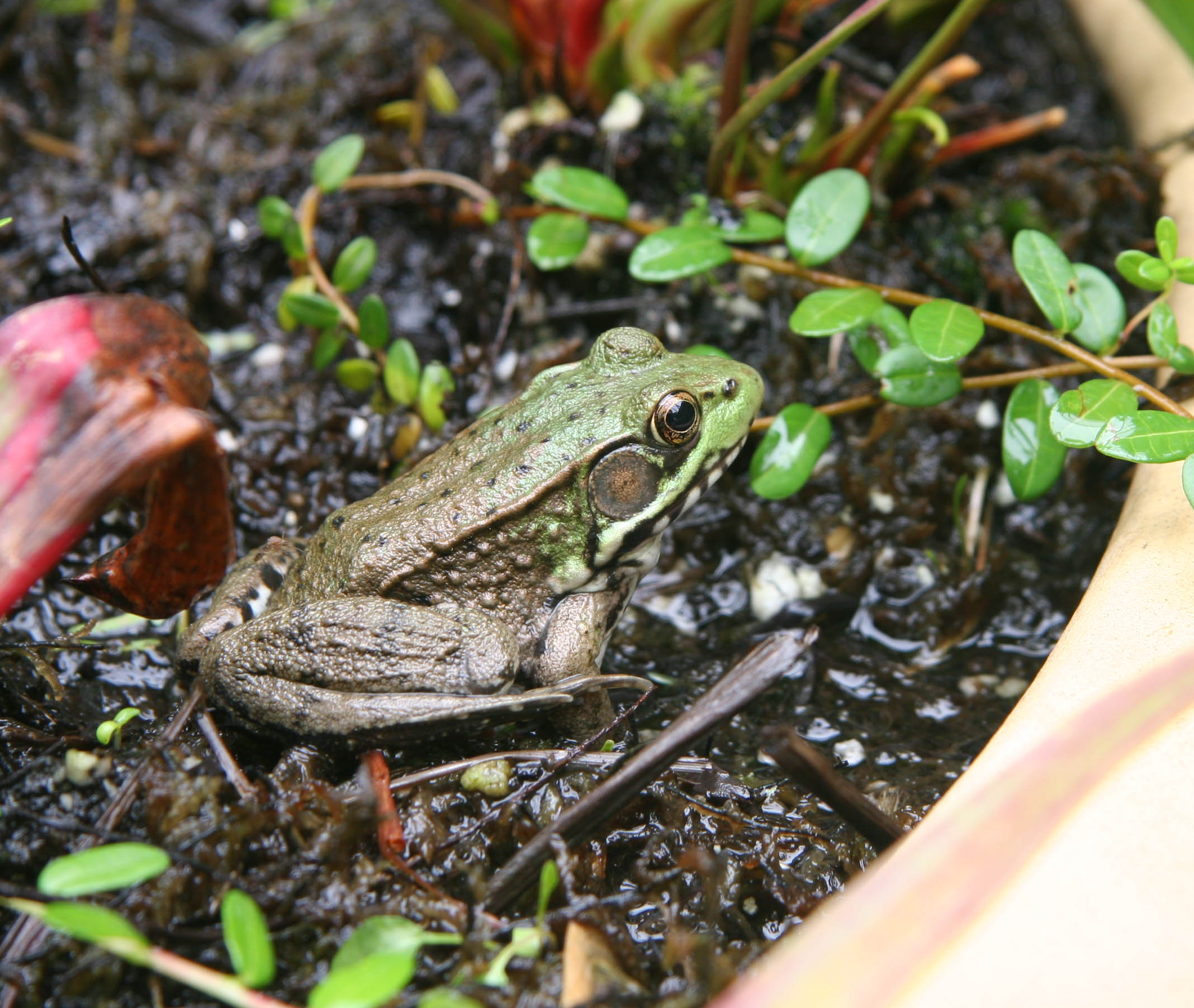
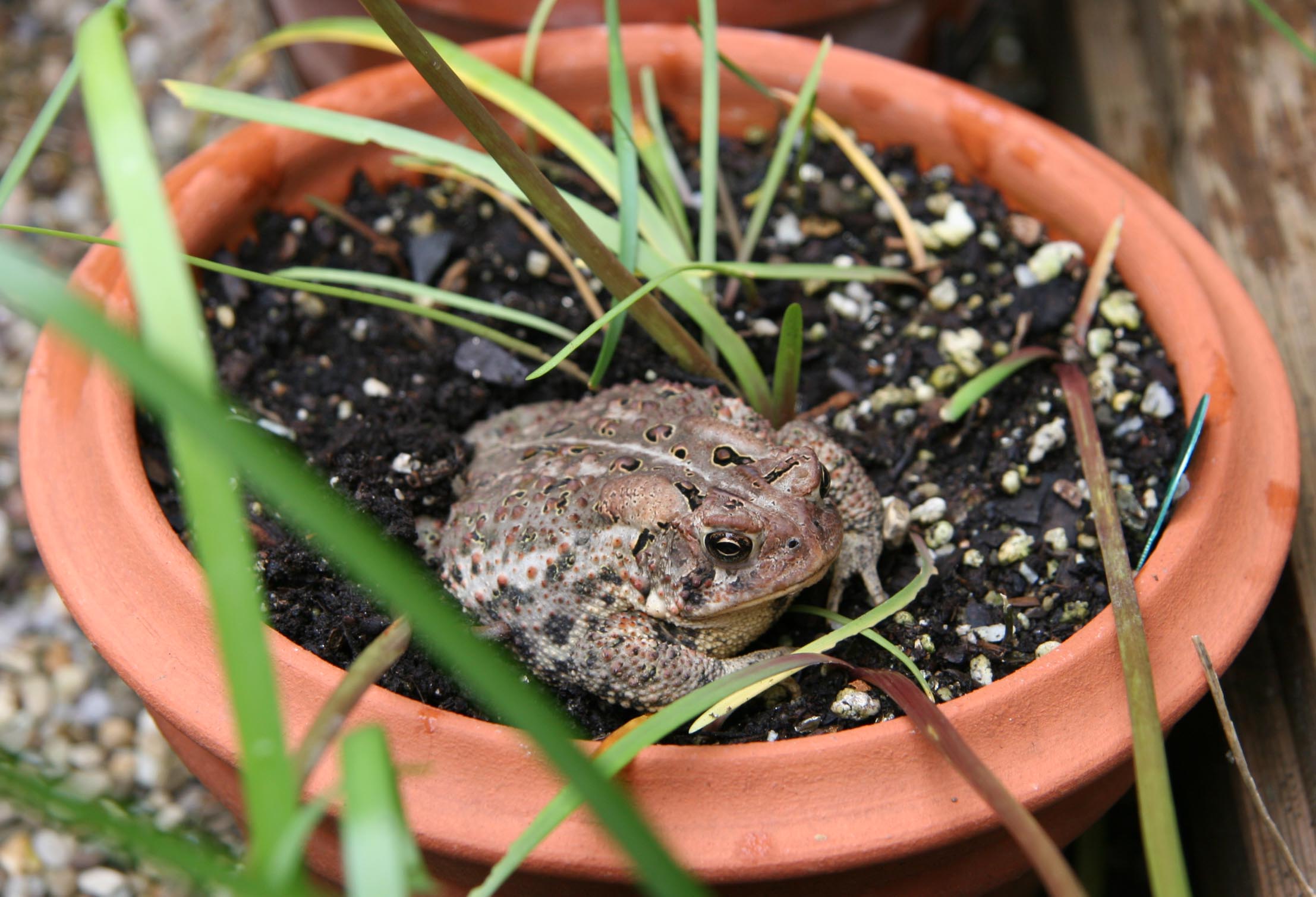
From the deer: The hostas were particularly delicious this year. We tried some other plants that were new to us; quite tasty!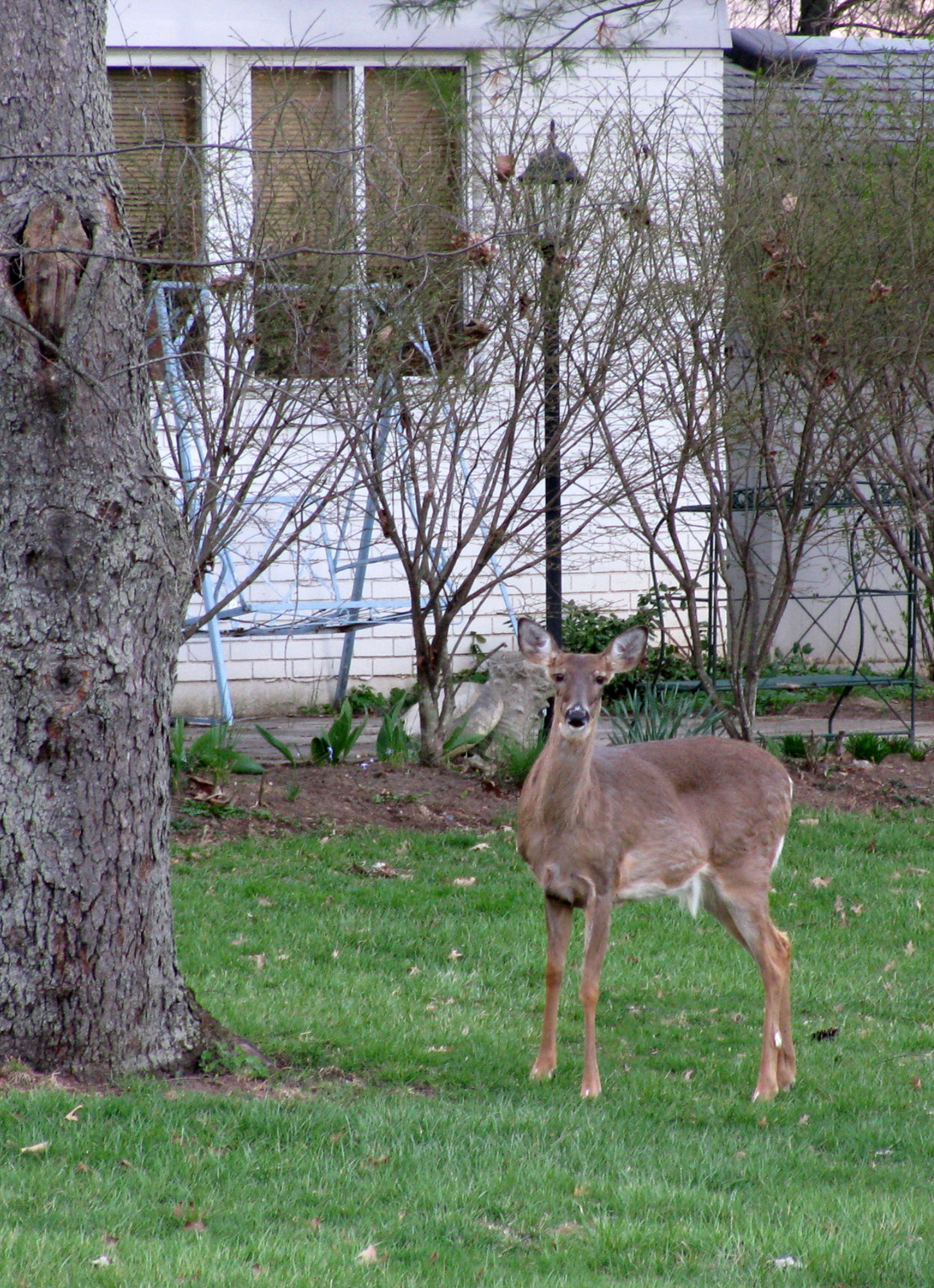
From the assassin bug: The bean trellises attracted quite a few insects for my eating enjoyment. I apologize for startling you as you were picking beans for dinner. I hope you noticed I moved quickly away from your hand.
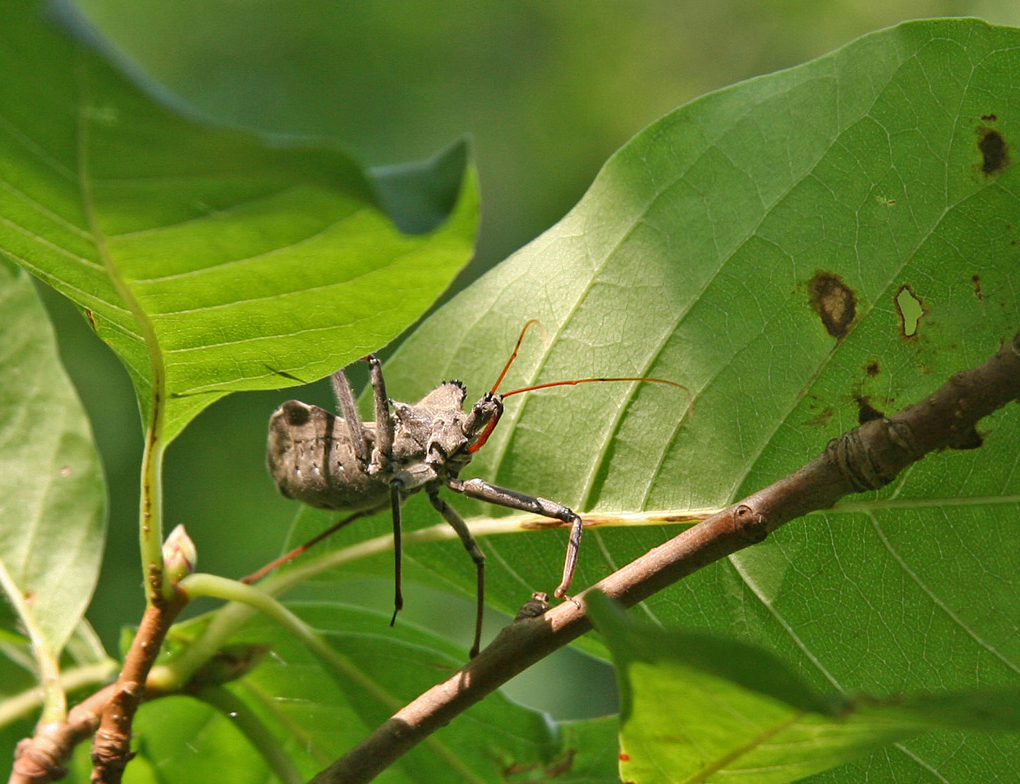
I was not carrying my camera while harvesting beans, so here is an assassin bug in my magnolia.
From the bees: Thank you for the myriad of blooms that sustained us through this tough season. The spring was very wet and it was a challenge to gather nectar and pollen in the rain. We made up for it in your summer and fall flowers.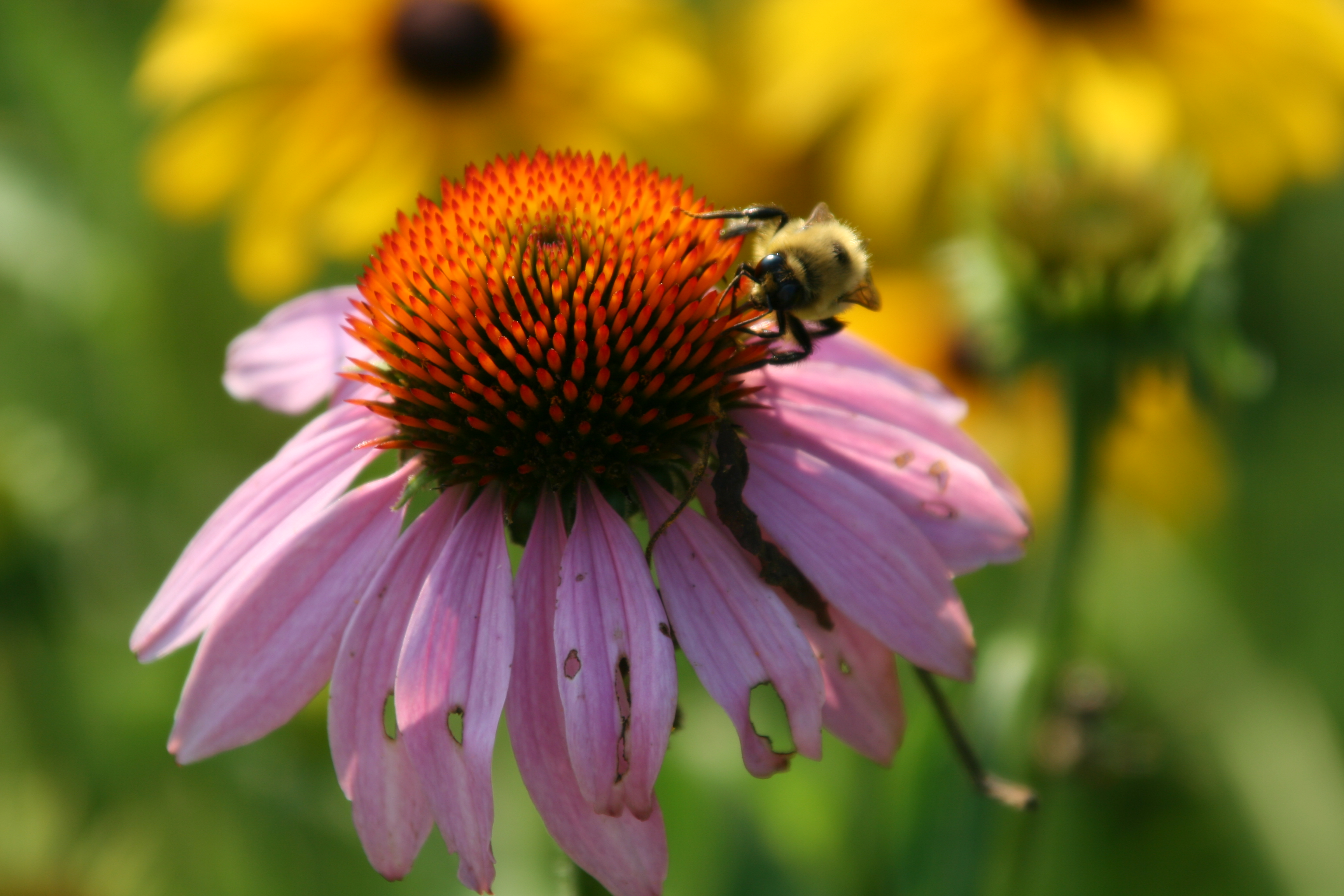
From the spiders: We appreciate that you did not remove us from your window by your sink and over your front door (sorry about scaring your daughter, but we noticed that your granddaughter thought we were cool). both places were perfect for catching unwary insects.
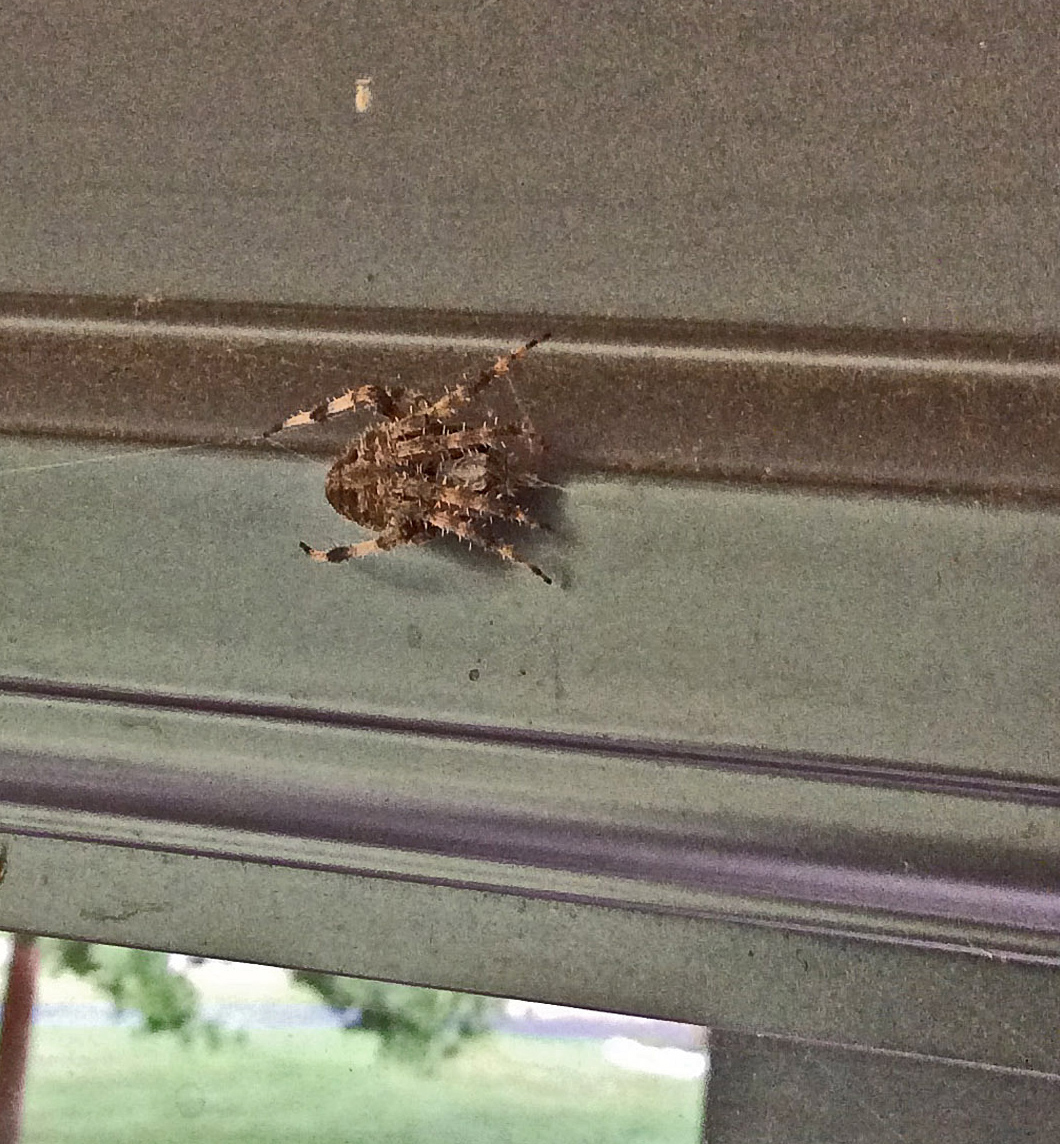
She was about 1” in diameter when her legs are pulled in close to her body as you see here. Fully extended she was over 1 ½” in diameter. Here she is perched above the door, in the shade, during the day.
PS: Thank you to all of the species that share “my” garden. I have enjoyed watching you and learning so many lessons.
by GardenLover | Nov 19, 2015 | Gardens to Drive
Remember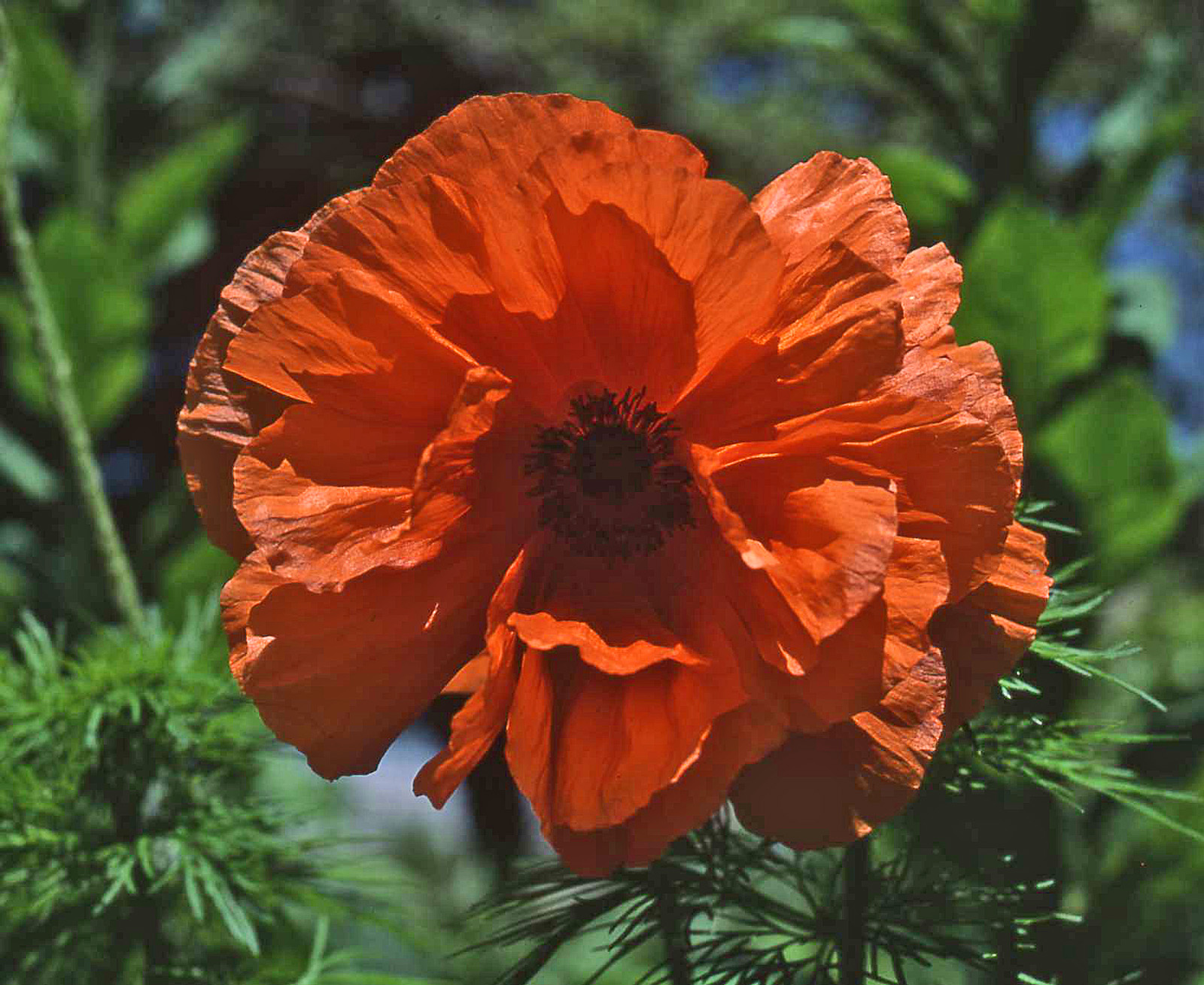
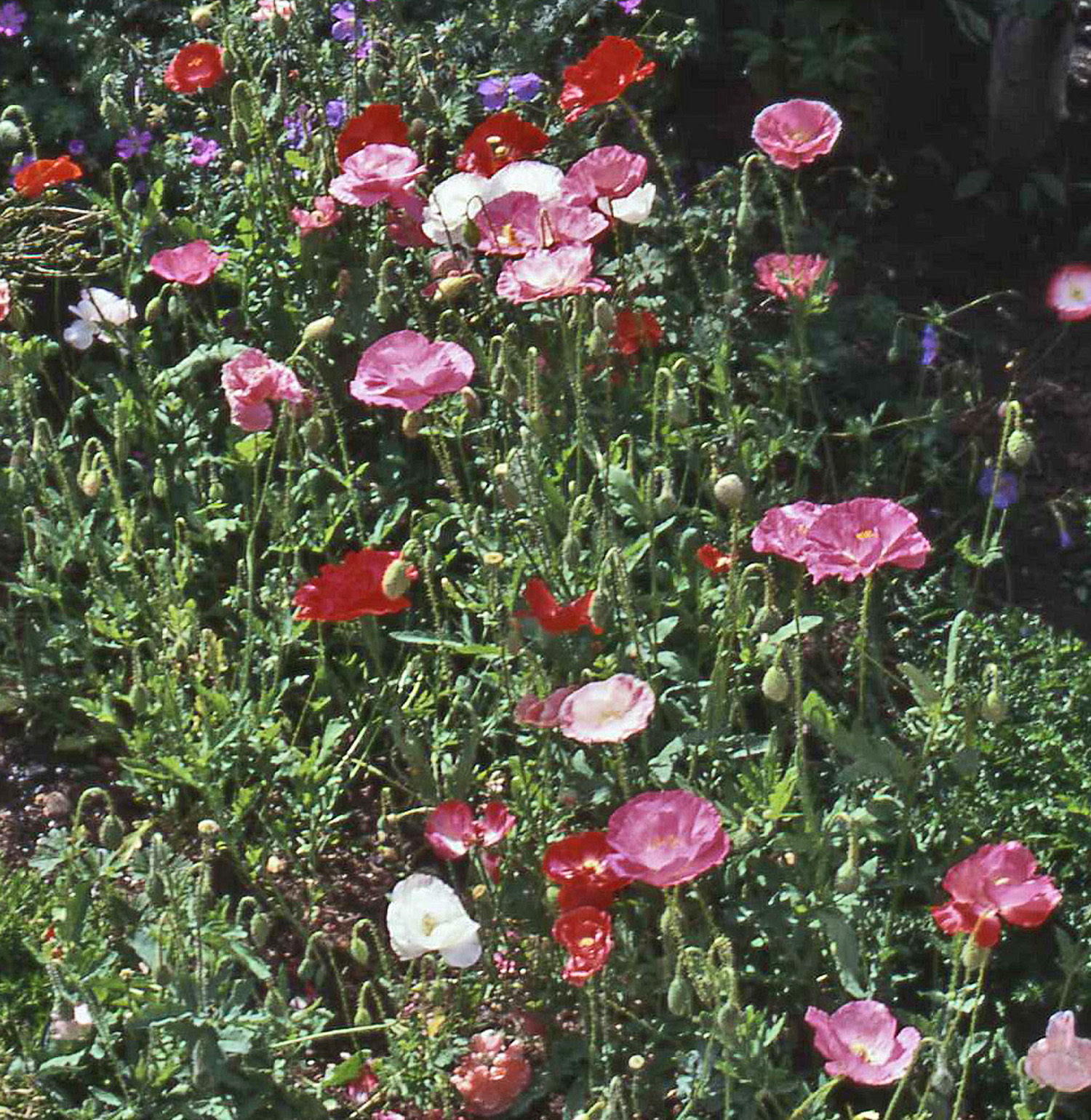
by GardenLover | Nov 10, 2015 | Garden profile, Misc., Special Topic
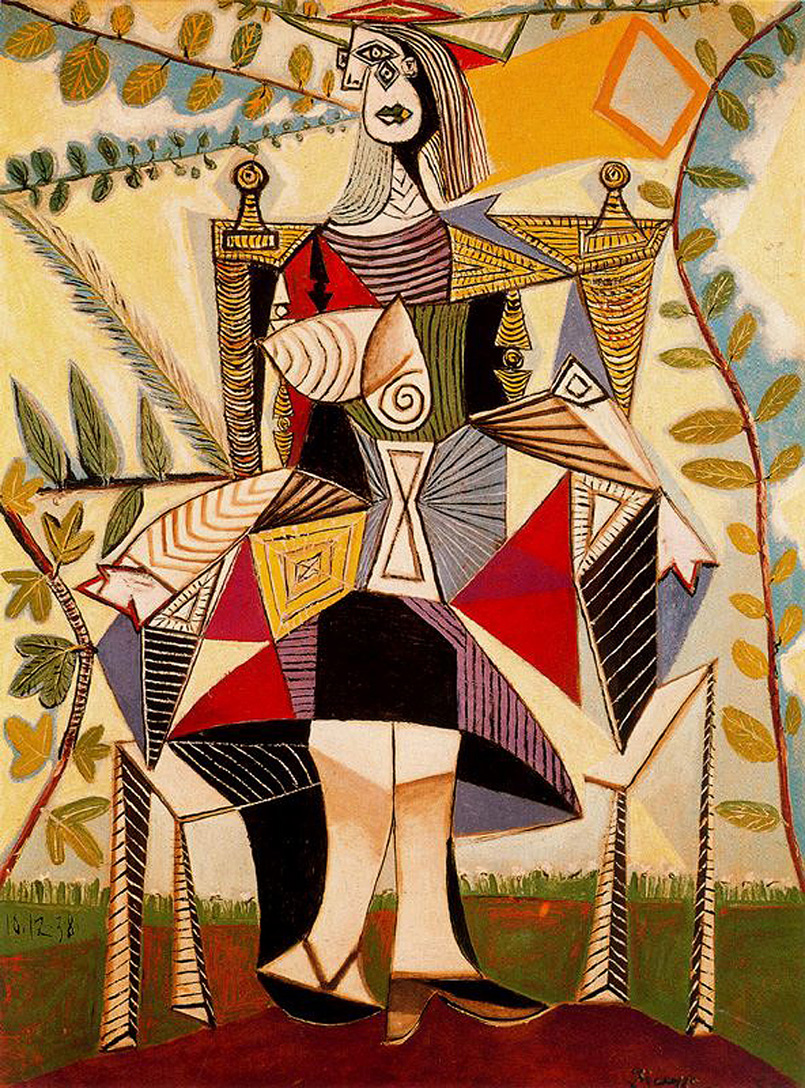 Six Timeless Quotes To Inspire Fresh Garden Ideas
Six Timeless Quotes To Inspire Fresh Garden Ideas
By Teresa Woodard
As gardeners reflect on the past season and plan for the next, I thought I’d share these inspiring quotes from painting master Pablo Picasso as they were restated in a recent story in Entrepreneur magazine.
- Bad artists copy. Good artists steal. Just as in the art world, no ideas in the gardening world are new. So, yes, I’ll be stealing lots of ideas — like elements of this massive border — from this summer’s round of garden tours.
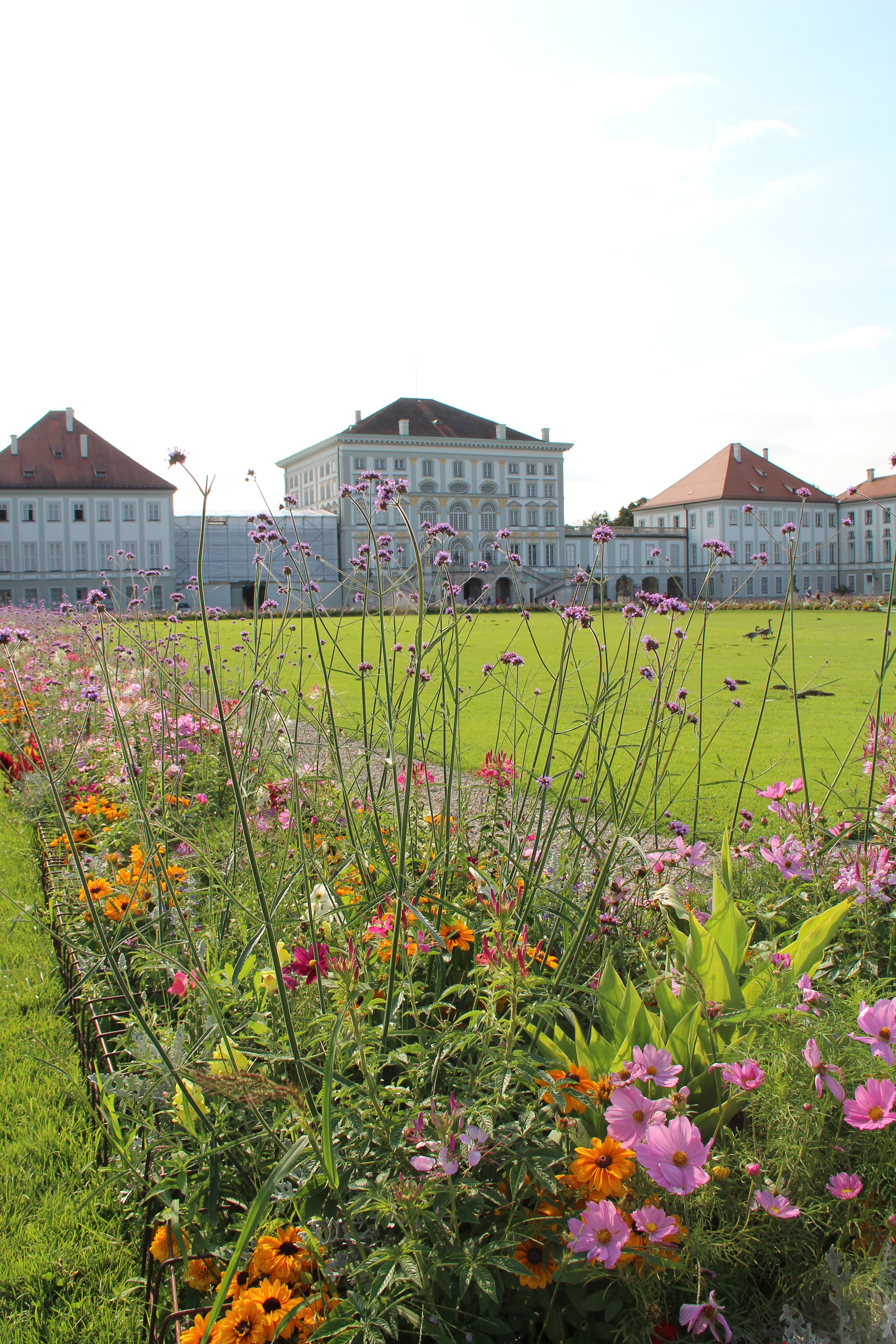
- Everything you can imagine is real. A few gardens I saw this year truly stretched my imagination. For example, King Ludwig’s underground garden grotto or the Bellagio Conservatory’s crane topiary may seem a bit surreal, but they do inspire big thinking.

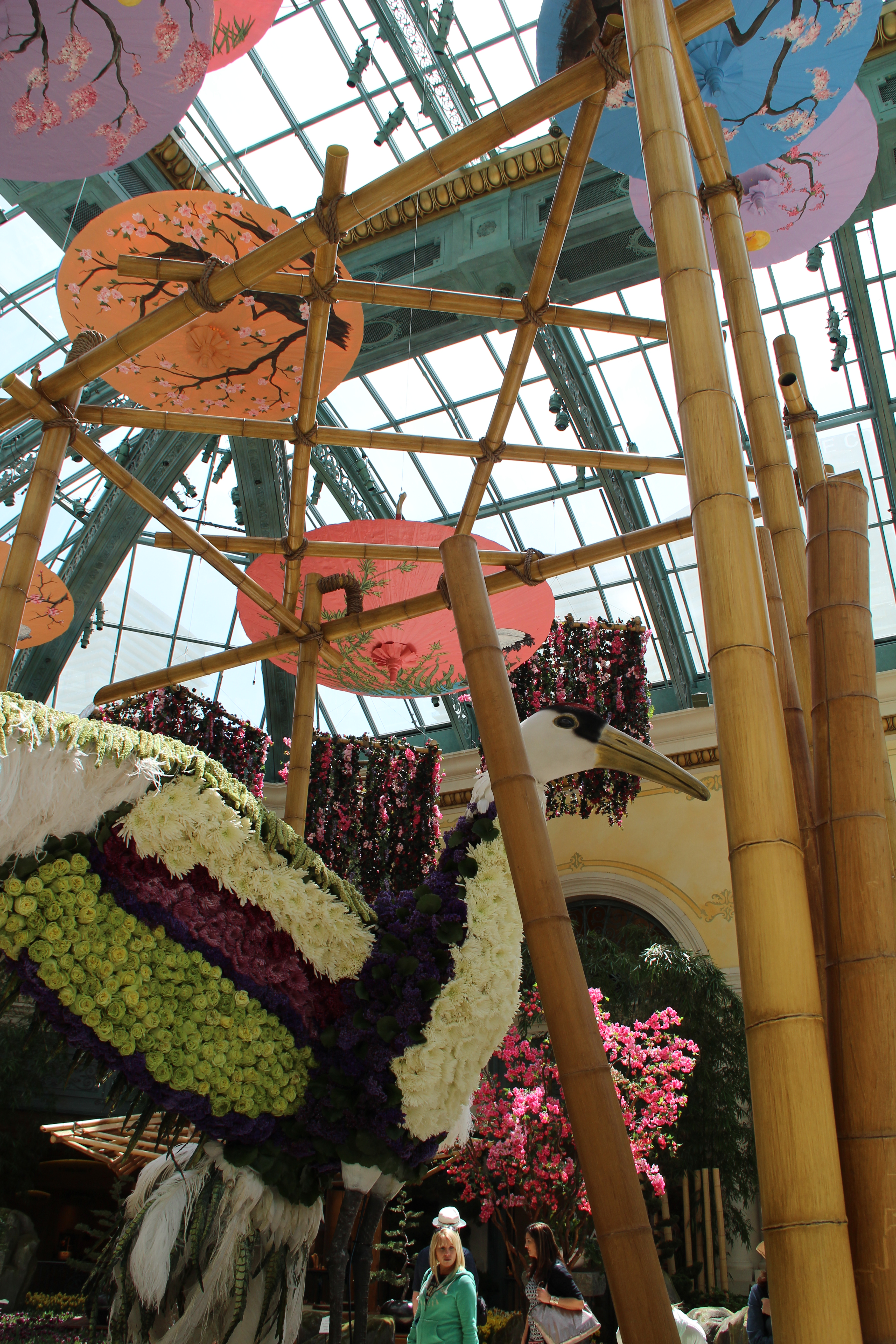 Art is the elimination of the unnecessary. As a garden writer, I tend to collect too many different plants which often creates a cluttered look in my garden. So, a goal for next season is to accumulate more of the most dazzling plants and donate those unnecessary ones to the Master Gardener Volunteers’ spring plant sale. One day, I’m envisioning rivers of plants like these Adrian Bloom designs
Art is the elimination of the unnecessary. As a garden writer, I tend to collect too many different plants which often creates a cluttered look in my garden. So, a goal for next season is to accumulate more of the most dazzling plants and donate those unnecessary ones to the Master Gardener Volunteers’ spring plant sale. One day, I’m envisioning rivers of plants like these Adrian Bloom designs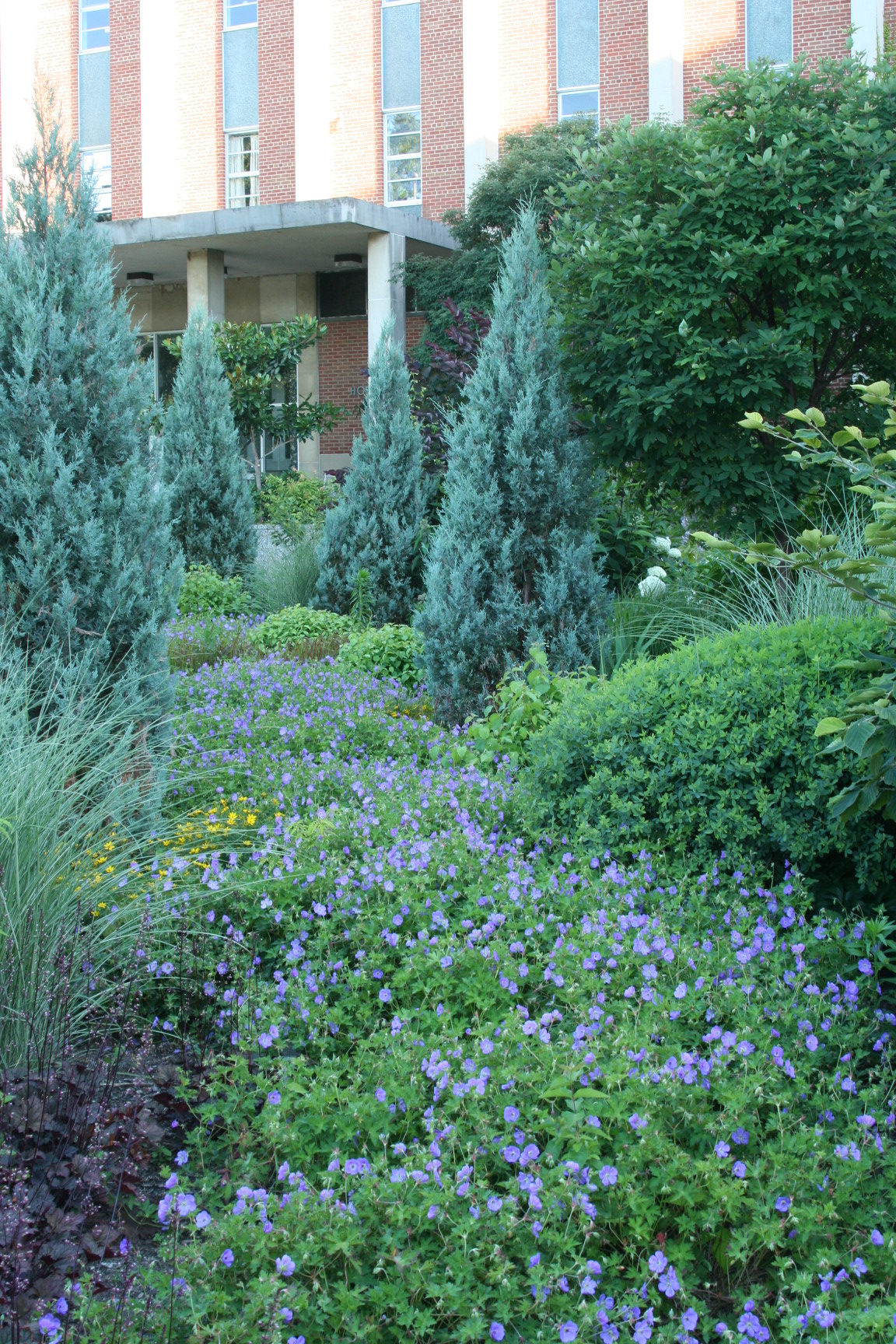
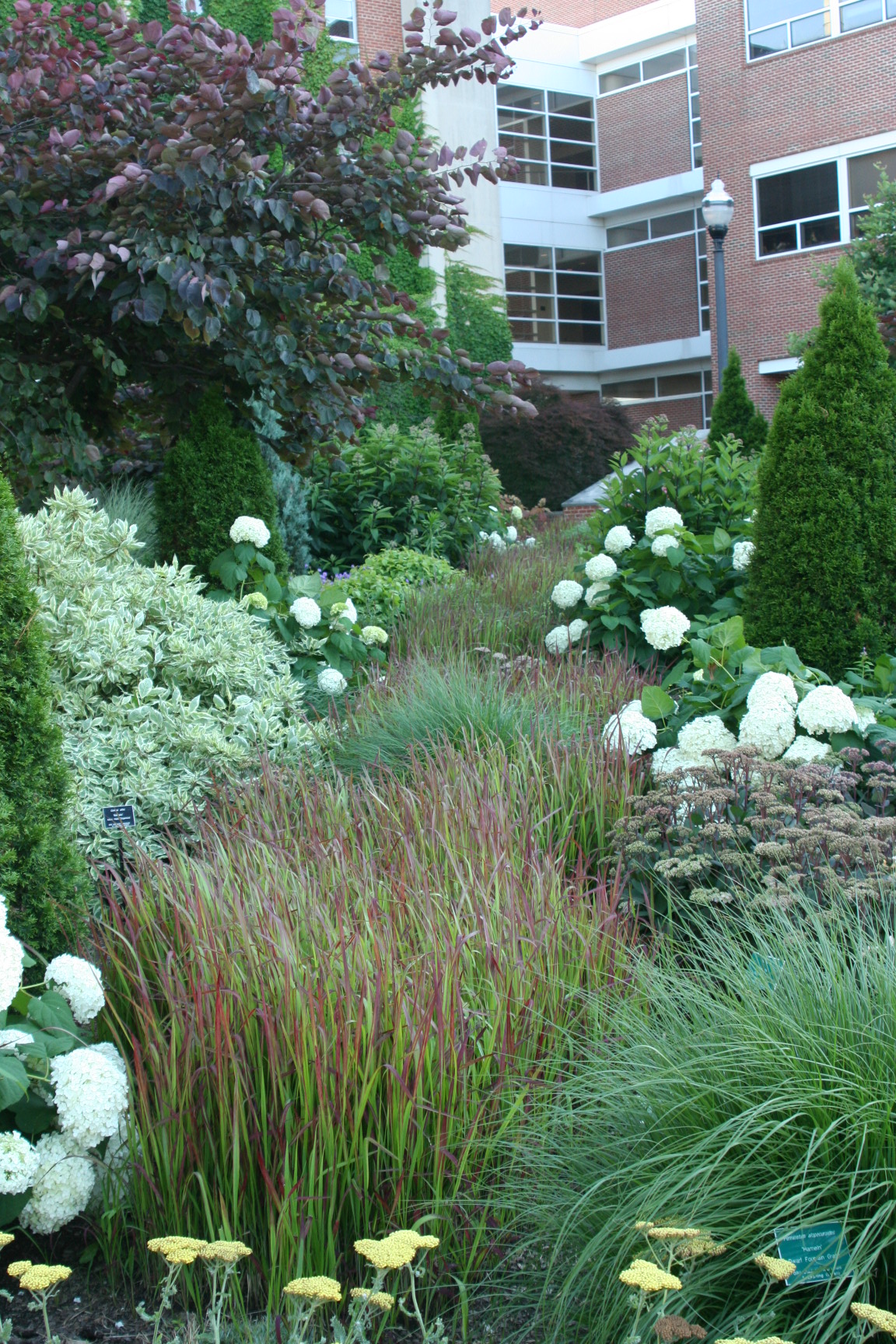 at Chadwick Arboretum.
at Chadwick Arboretum.- Action is the foundational key to all success. Can I hear an “Amen”? This truth undoubtedly applies to gardening and anything else in life. So, check back with me in a year, and see if I took action on the 10 new ideas in my journal to-do list.
 All children are artists. The problem is how to remain an artist once we grow up. I’m grateful to have teenagers and young neighbors to bring their youthful spirit to the garden. Thanks to them I planted peanuts, apple gourds, ghost peppers and crazy succulents. Some ghost peppers even ended up in the high school cafeteria and caused several dared friends to lose their lunch as they choked them down whole.
All children are artists. The problem is how to remain an artist once we grow up. I’m grateful to have teenagers and young neighbors to bring their youthful spirit to the garden. Thanks to them I planted peanuts, apple gourds, ghost peppers and crazy succulents. Some ghost peppers even ended up in the high school cafeteria and caused several dared friends to lose their lunch as they choked them down whole.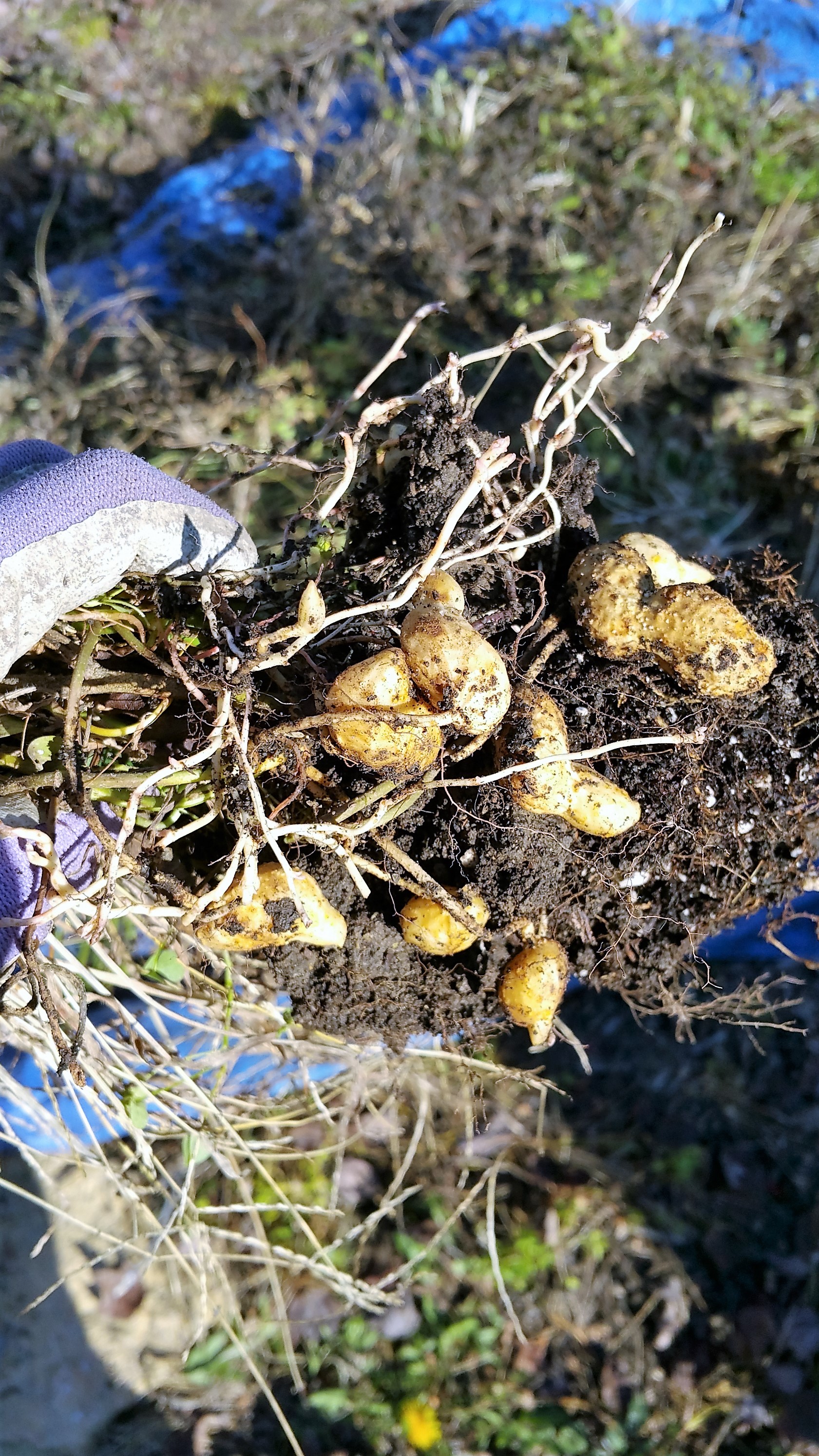 I paint objects as I think them, not as I see them. As I hack ideas from great garden designs, I can bend them to my own vision for my space, budget, growing zone and personal style. Here, I’ve planted hundreds — not thousands — of Spanish bluebells (Hyacinthoides hispanica) to achieve my own scaled-back version of this spectacular tulip display.
I paint objects as I think them, not as I see them. As I hack ideas from great garden designs, I can bend them to my own vision for my space, budget, growing zone and personal style. Here, I’ve planted hundreds — not thousands — of Spanish bluebells (Hyacinthoides hispanica) to achieve my own scaled-back version of this spectacular tulip display.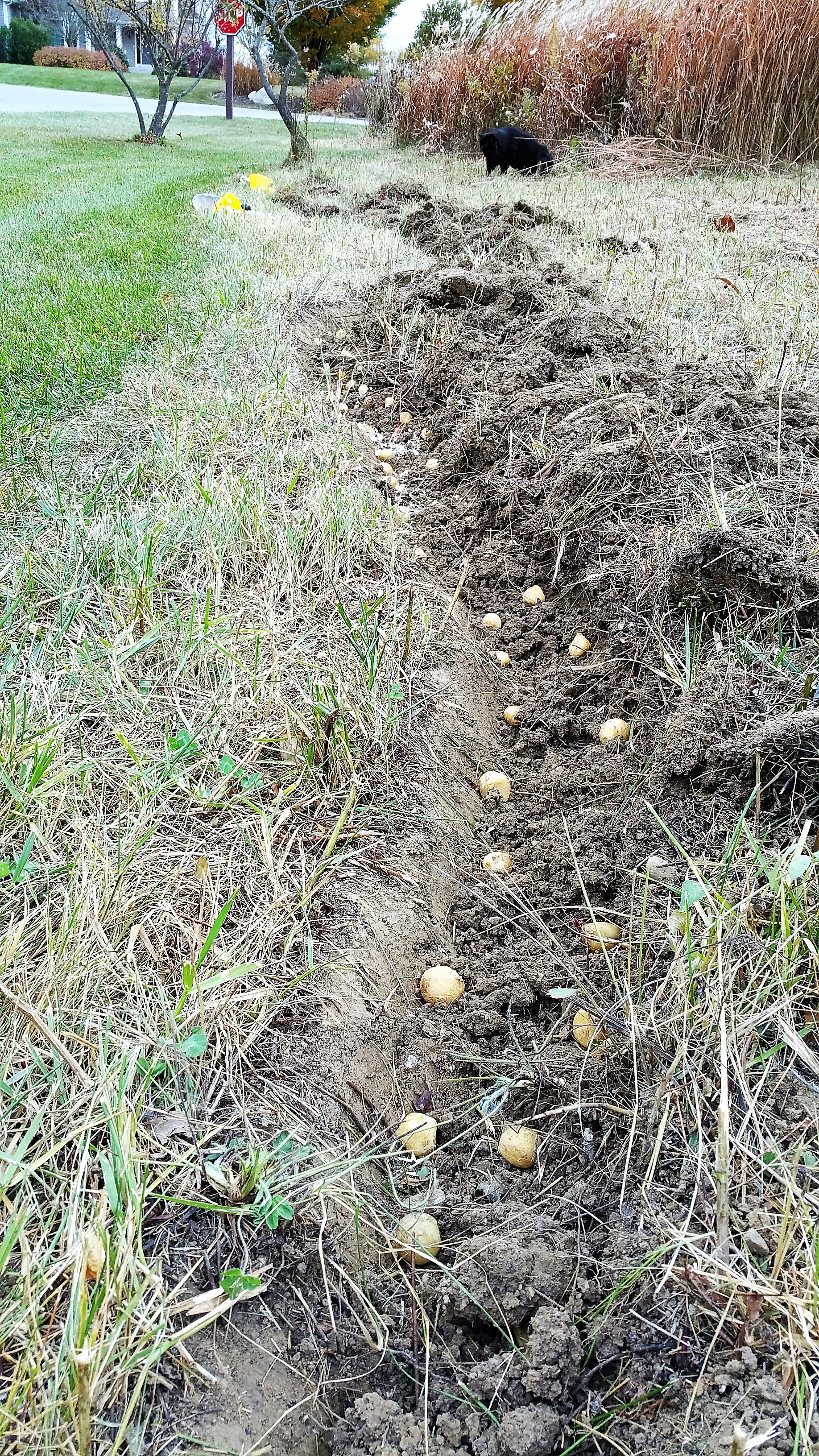
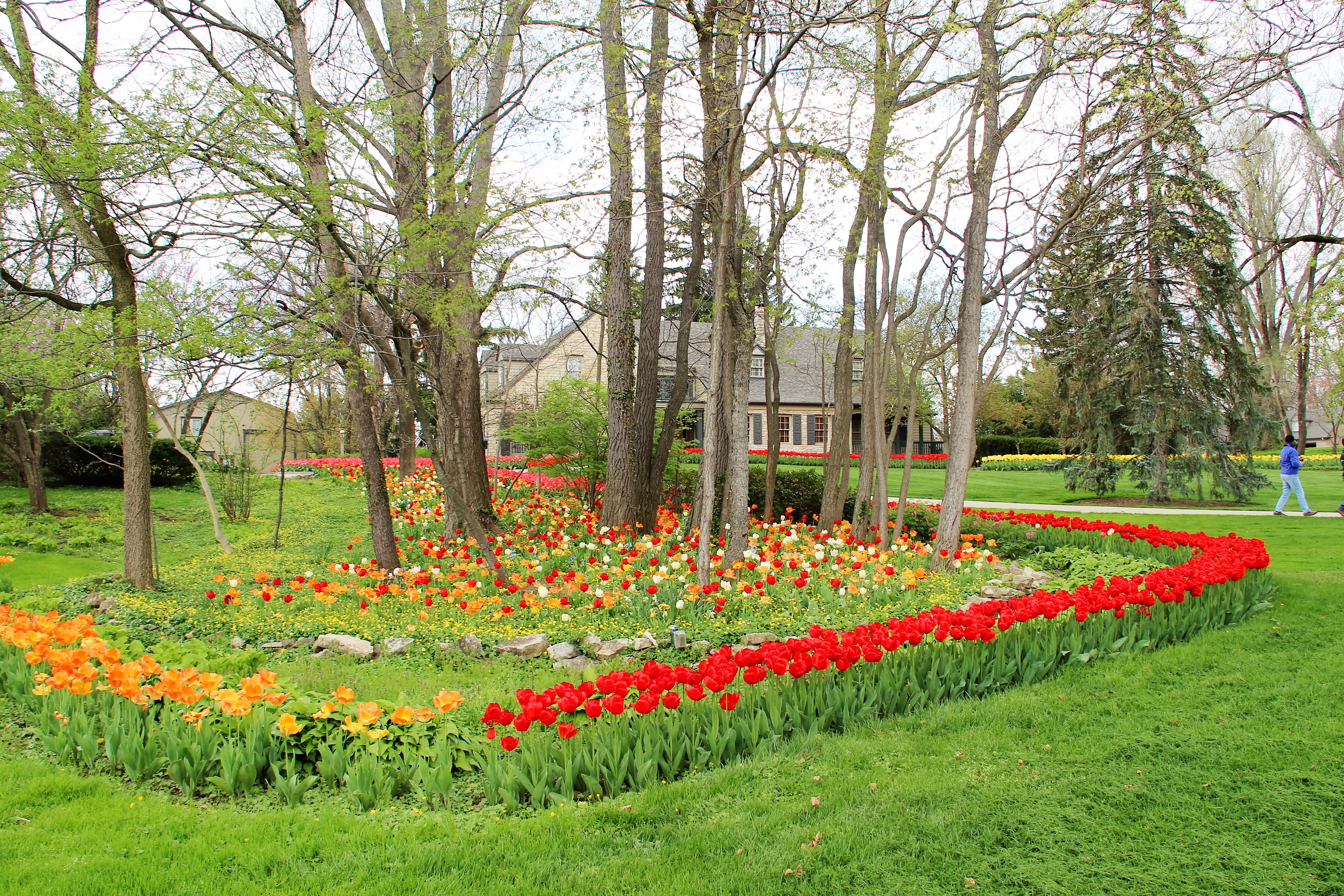
Check out the After Picasso: 80 Contemporary Artists at the Wexner Center for the Arts, through Dec. 27.

 This is an update of his 1992 book The Natural Shade Garden which has held an honored place on my bookshelf and in my design classes. I find that updates are nice, but they often don’t offer much more than the original. This is not the case with The New Shade Garden. Druse discusses the issues of lawn, chemical use, the slippery classifications of native-local-nonnative plants, and sustainability. His guidance for matching plant combinations to garden conditions is excellent. He states, “The garden of the future will be a shade garden.” Why? Trees and their associated ecosystems are an essential part of our mature forests. Plus, they offer ecological services such as carbon sequestration, modifying temperature around buildings, stormwater control and more.
This is an update of his 1992 book The Natural Shade Garden which has held an honored place on my bookshelf and in my design classes. I find that updates are nice, but they often don’t offer much more than the original. This is not the case with The New Shade Garden. Druse discusses the issues of lawn, chemical use, the slippery classifications of native-local-nonnative plants, and sustainability. His guidance for matching plant combinations to garden conditions is excellent. He states, “The garden of the future will be a shade garden.” Why? Trees and their associated ecosystems are an essential part of our mature forests. Plus, they offer ecological services such as carbon sequestration, modifying temperature around buildings, stormwater control and more. Another library find was Toby Hemenway’s The Permaculture City: Regenerative Design for Urban, Suburban and Town Resilience. You may be familiar with his excellent guide to creating a sustainable home garden: Gaia’s Garden: a Guide to Home-Scale Permaculture. In The Permaculture City, Hemenway expands the scope of his first book; starting at the home garden – focusing especially on urban sites, then branching out into the community. His topics range from understanding, using and protecting water sources of the community to creating local money systems that sustain a community. The latter topic offers a different way to think about money and banks. As in Gaia’s Garden, Hemenway offers examples and practical applications of permaculture techniques and concepts.
Another library find was Toby Hemenway’s The Permaculture City: Regenerative Design for Urban, Suburban and Town Resilience. You may be familiar with his excellent guide to creating a sustainable home garden: Gaia’s Garden: a Guide to Home-Scale Permaculture. In The Permaculture City, Hemenway expands the scope of his first book; starting at the home garden – focusing especially on urban sites, then branching out into the community. His topics range from understanding, using and protecting water sources of the community to creating local money systems that sustain a community. The latter topic offers a different way to think about money and banks. As in Gaia’s Garden, Hemenway offers examples and practical applications of permaculture techniques and concepts. to peruse and review if I felt it was worthy. I enjoyed the author’s previous book Safe Sex in the Garden and Other Propositions for an Allergy-free World (2004) and was curious about his next step. In The Allergy Fighting Garden, Ogren combines and expands his two earlier books: Allergy Free Gardening (2000) and Safe Sex in the Garden. He offers a concise presentation of his rating scale, OPALS (Ogren Plant Allergy Scale), for allergen producing plants and a comprehensive list of garden plants that are rated for their allergen-producing potential. His rationale for his scale is based on solid plant science and is easy to understand. The scale is 1-10 with 1 being “least allergenic” and 10 being “most allergenic”. For example: boxwood rates a 7 because the male flowers need to make enough pollen to reach the female flowers, via the wind, that are on separate plants (boxwood is dioecious-having different sexed flowers on separate plants). Ogren also notes that boxwood can cause a dermatitis reaction for sensitive individuals.
to peruse and review if I felt it was worthy. I enjoyed the author’s previous book Safe Sex in the Garden and Other Propositions for an Allergy-free World (2004) and was curious about his next step. In The Allergy Fighting Garden, Ogren combines and expands his two earlier books: Allergy Free Gardening (2000) and Safe Sex in the Garden. He offers a concise presentation of his rating scale, OPALS (Ogren Plant Allergy Scale), for allergen producing plants and a comprehensive list of garden plants that are rated for their allergen-producing potential. His rationale for his scale is based on solid plant science and is easy to understand. The scale is 1-10 with 1 being “least allergenic” and 10 being “most allergenic”. For example: boxwood rates a 7 because the male flowers need to make enough pollen to reach the female flowers, via the wind, that are on separate plants (boxwood is dioecious-having different sexed flowers on separate plants). Ogren also notes that boxwood can cause a dermatitis reaction for sensitive individuals.






















